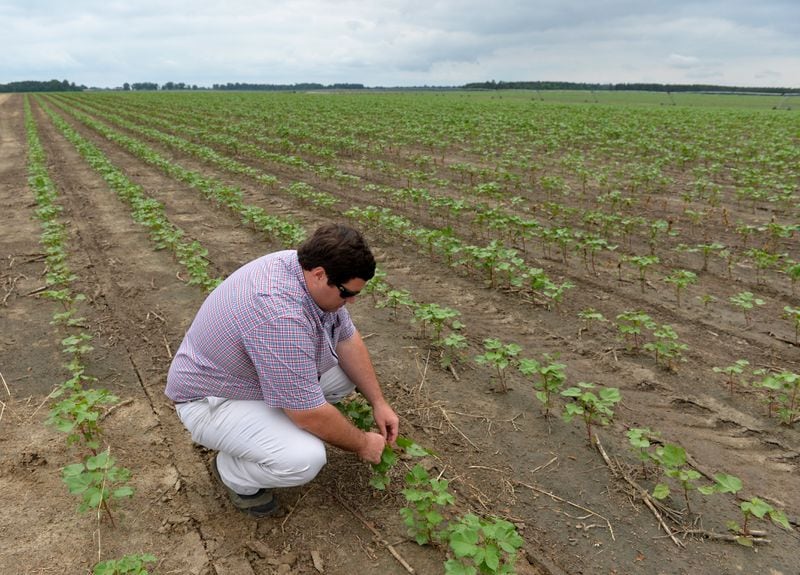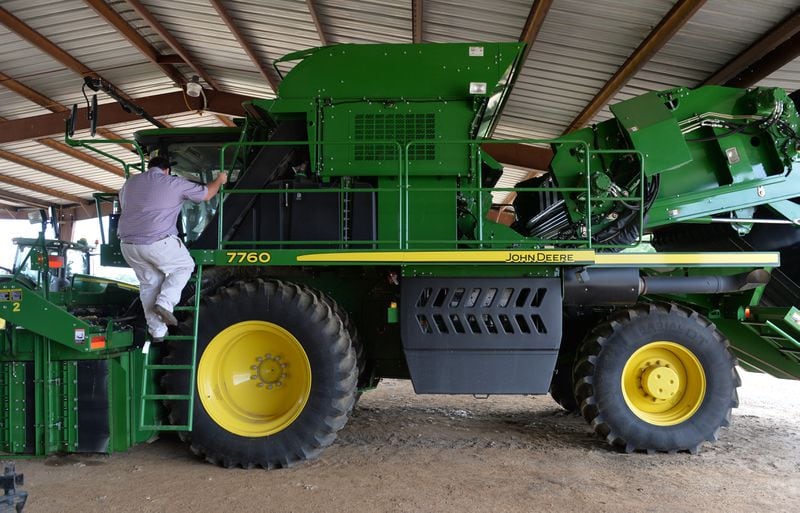Size, flexibility and multiple revenue streams.
Those are the keys that have helped Matt Coley and his father, Chuck, weather the economic storm that farmers here in the heart of Georgia’s cotton country say has hobbled their balance sheets in recent years.
“Every year seems like it costs a little more to get a crop in the ground, grow it and harvest it,” said Matt Coley, a Georgia Cotton Commission member and fourth-generation farmer, as he sat in his wood-paneled office filled with University of Georgia memorabilia.
After years of stubbornly low commodity prices and a glut of cotton supply on the world market, stakeholders from Georgia to California warn that irreversible damage to farms and farmers may have already been done.
Washington devotes billions in subsidies to help farmers weather such economic hardships. But a recent international trade dispute has kneecapped one of the central tenets of the U.S. government’s cotton aid system, making it effectively useless, stakeholders say.
“There’s nothing there for the cotton farmers to fall back on,” said Gerald Long, president of the Georgia Farm Bureau, who himself grows cotton and a slew of other crops at his farm near Bainbridge. “Right now, the price of cotton is below our cost of production.”
The Coleys’ 3,800-acre farm in Vienna is on the larger side, which helps make investments in new equipment such as a cotton picker — they typically run three-quarters of a million dollars apiece — more feasible because of economies of scale.
The family owns a gin, which allows them to pull in extra income from other local farmers looking to process their cotton crop. They also grow peanuts, which helps improve the farm’s soil and just as critically functions as a fallback option when cotton prices are low — as they generally have been in recent years.
Under pressure from outside groups, members of Congress have signaled their plans to send cotton farmers a new set of emergency subsidies in the months ahead.
But not everyone thinks more federal money is warranted.
Some environmental and government waste groups point to recovering cotton yields and prices as reasons why farmers don’t need extra help from Uncle Sam.
“Cotton farmers don’t have a safety net,” said Scott Faber, vice president of government affairs at the Environmental Working Group. “They already have a trampoline.”
China and Brazil
Cotton has long shaped Georgia’s political and historical identity. Even today, it is an economic force to be reckoned with and one of the state’s top agricultural exports.
Georgia farmers planted nearly 1.2 million acres of it in 2016, according to federal figures, generating more than $1 billion in sales last year, the second most of any state.
Advocates say the industry is only just now beginning to recover after a troubled few years.
“Certainly there’s been a tremendous amount of pain for people whose businesses revolve around (cotton),” said Republican U.S. Rep. Austin Scott, whose 8th Congressional District in south-central Georgia is dotted with fluffy white cotton buds.
Industry stakeholders pin many of their troubles on two particular trading partners: China and Brazil.
China all but dictates the global market for cotton. The lion’s share of U.S.-grown cotton is exported there and to other Southeast Asian textile behemoths such as Bangladesh and Vietnam. And among the bales that stay in America, much is spun into yarn that is then exported across the Pacific.
In 2011, China went on a shopping spree, snapping up half of the world's cotton that year, and then sat on it. The move depressed the price of the commodity worldwide while tamping down on production in places as far away as the Peach State.
China recently began auctioning off its cotton, but it’s not the only country that local farmers say has thrown a wrench into their bottom lines.
Brazil spearheaded perhaps the industry’s most profound economic change in recent years after it successfully sued the United States in an international trade court in 2002 alleging unfair trade practices. In order to avoid bruising tariffs, the U.S. agreed to pay Brazil hundreds of millions of dollars and effectively end its most substantial cotton subsidy program.
Farmers could still receive federally backed crop insurance, as well as enter into a loan assistance program. But cotton’s boosters argue the trade case with Brazil — as well as the world’s growing taste for polyester and other cheaper alternatives to cotton — blew holes into their balance sheets at a time when their economic situation was dire.
Not about getting rich
Many stakeholders are looking to have those cotton-specific subsidies essentially reinstated in next year’s farm bill. The money, they say, is not enough to make them rich, but it would help to keep their finances afloat through bad economic years.
“What’s at stake really is the health of rural communities,” said Georgia Agriculture Commissioner Gary Black. “It is about survival because agriculture on the world stage is a very volatile business.”
Farming comes with high upfront costs, stakeholders say. Securing the land, equipment and labor required to operate a farm often costs millions of dollars. And while many farmers have been able to rotate in peanuts or corn as a substitute for cotton in times of lower federal support, they warn that prolonged economic troubles could lead to farmers being denied loans to invest in land or new equipment. It could also force people to eventually scale back their operations or sell their farms altogether.
“We’ve got farmers each year that go out of business that cannot continue,” said Long. “The margins are so close, the risk is so great. The equipment cost is unbearable. When you put all those combinations together, you cannot afford to make a mistake, whether it’s your mistake or Mother Nature’s mistake.”
Members of Congress have signaled that more money is likely on the way, perhaps within weeks.
Lawmakers slipped a provision into the latest emergency spending bill providing relief for hurricane victims that would make certain types of cotton and cottonseed eligible for new subsidies.
The natural disaster bill is still being negotiated on Capitol Hill, but it’s looking increasingly likely that lawmakers will be sending cotton farmers some sort of interim financial help in early 2018, either through that measure or wrap-up government spending legislation.
Those changes will set the table for an even larger overhaul of cotton subsidies expected later in the year, when the House and Senate agriculture committees negotiate the next farm bill. Cotton boosters are lobbying hard for bigger subsidies for their commodity.
“We don’t want to guarantee anybody a profit, but we want to be able to put in some type of stop-loss in there so that farmers can protect themselves from the downside risk of both a bad crop year and a bad price year,” said Scott, who is a member of the House Agriculture panel.
Cotton advocates will need to fight against other crops duking it out for the same scarce government money. But with several Georgians sitting on the House and Senate Agriculture Committees and former Gov. Sonny Perdue now the U.S. secretary of agriculture, Southern crops may be in a better negotiating position.
More than a fair share?
There has long been friction between cotton supporters and the boosters of other commodities, such as corn and soybeans, that have long competed for federal support every six years when the farm bill is renegotiated. Many have felt that cotton was a favored child.
“Historically and currently, cotton has always gotten more than its fair share of subsidies,” said Faber, the Environmental Working Group vice president.
He said Congress should not risk igniting a renewed trade battle with Brazil by beefing up cotton subsidies over the next year.
Josh Sewell, a senior policy analyst at the anti-government waste group Taxpayers for Common Sense, said agricultural lobbyists always try to convince Congress they have had a bad few years in order to receive more subsidies, regardless of whether that is true.
Sewell said Congress should take a much more scaled-back approach to farm subsidies. He said markets would be more efficient in determining winners and losers — a more desirable outcome, even if that means fewer cotton acres being planted.
Cotton “seems to be the commodity that is the least willing to adapt to the globalized market,” he said.
With cotton yields increasing, the industry should focus on lobbying the government to push other countries for fairer trade practices, not more subsidies, Sewell said.
“You want to free farmers,” he said. “Give them the opportunity to plant for the market, not to the edicts of Washington or to their bankers, which is what we’re doing now.”
Back in Vienna, the Coley farm has harvested its cotton crop for the year and is wrapping up its final weeks of ginning work. Locals were hoping for a blockbuster cotton yield this year, but heavy rains dampened final totals.
Despite that, Matt Coley has high hopes for 2018.
“No matter how bad a year was, we’re always optimistic about next year’s crop,” he said.
Georgia’s top agricultural commodities by value, 2015
1. Broiler chickens $4.4 billion
2. Eggs $937 million
3. Beef $923 million
4. Cotton $713 million
5. Peanuts $685 million
Source: University of Georgia Center for Agribusiness & Economic Development
Cotton production by U.S. states, 2016
1. Texas 6.3 million bales
2. Georgia 2.6 million bales
3. Mississippi 1.1 million bales
4. Arkansas 800,000 bales
5. California 685,000 bales
Source: U.S. Department of Agriculture National Agricultural Statistics Service








